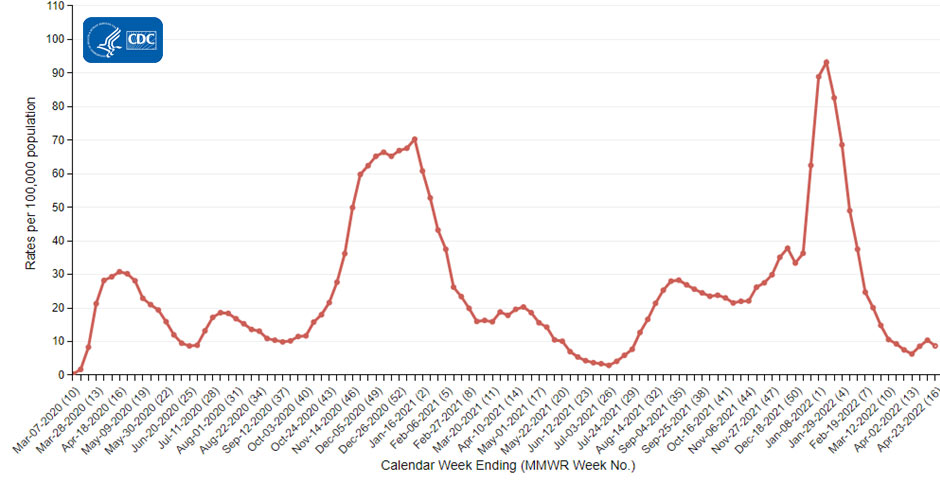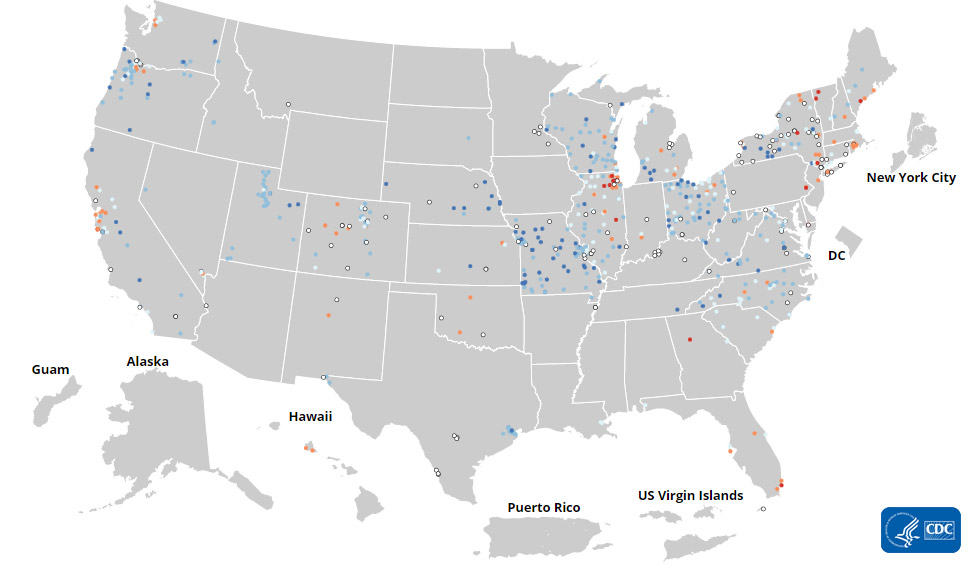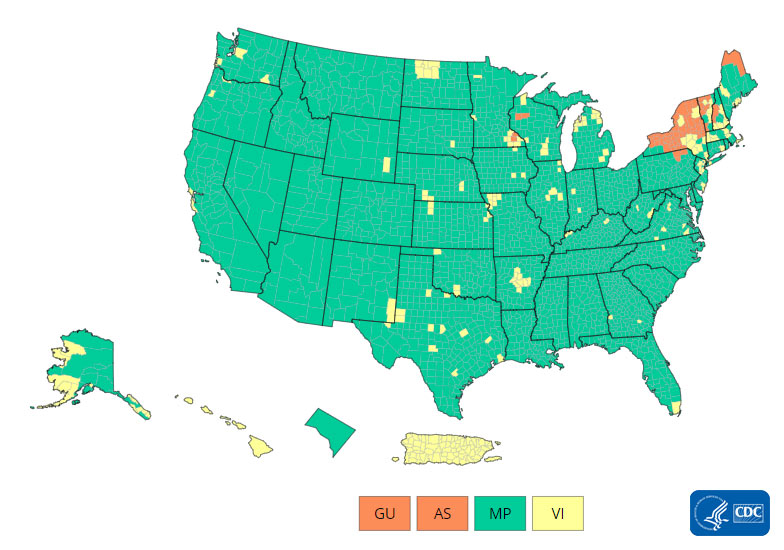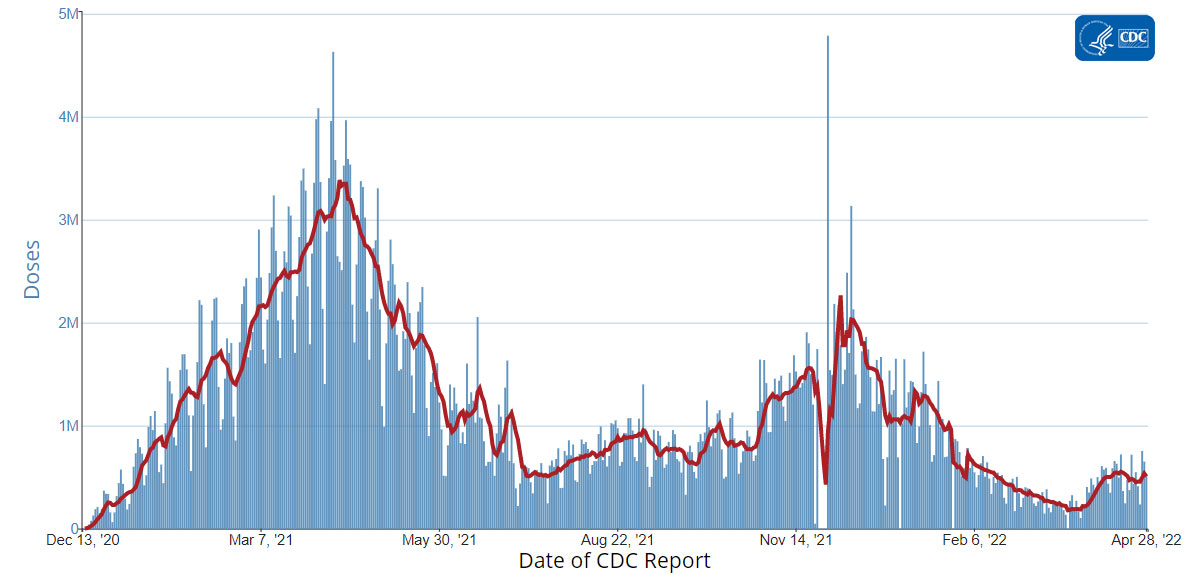Recommendations for Fully Vaccinated People
COVID-19 Homepage
Up to Date, Feeling Great
Interpretive Summary for April 29, 2022
Up to Date, Feeling Great
This week, the U.S. COVID-19 Vaccination Program marks two milestones: 500 days since the first COVID-19 vaccine was approved for use in the United States, and 100 million first booster doses administered. While 100 million boosters is certainly something to celebrate, the fact remains that half of those eligible for a COVID-19 booster shot—about 91 million people—have not yet received one. Staying up to date with COVID-19 vaccines, including recommended boosters, is the safest way to protect against severe outcomes from COVID-19.
Vaccines increase our protection against COVID-19, even for those with a previous COVID-19 infection. A new CDC study shows that the record number of infections during the Omicron wave gave many Americans infection-induced immunity. Between December 2021 and February 2022, the estimated percentage of the U.S. population with infection-induced antibodies increased from 34% to 58% across all age groups. The largest increases were in children and adolescents.
Reinfections can occur. Everyone should stay up to date with recommended COVID-19 vaccinations, including boosters for those who are eligible. In the United States, this means a primary series for everyone ages 5 years and older and a booster for everyone ages 12 years and older. Some people are also eligible to receive a second booster. Getting a COVID-19 vaccine is fast, easy, and free. Find a vaccine near you.
COVID-19 Community Levels
On February 25, 2022, CDC updated the way it monitors COVID-19’s impact on our communities. Widespread availability of vaccines and testing, advances in treatments, and increasing levels of immunity in the population through vaccination or previous infection have moved the COVID-19 pandemic to a new phase. While we can’t prevent all cases of COVID-19, we can continue to limit the spread and protect those who are most at risk of severe illness.
Currently, there are 54 (1.68%) counties, districts, or territories with a high COVID-19 Community Level, 256 (7.95%) counties with a medium Community Level, and 2,910 (90.37%) counties with a low Community Level. This represents a slight (0.59%) increase in the number of high-level counties, a small (+1.43%) increase in the number of medium-level counties, and a corresponding (−2.02%) decrease in the number of low-level counties. Seventeen (30.36%) of 56 jurisdictions had no high- or medium-level counties this week.
To check your COVID-19 community level, visit COVID Data Tracker.
Reported Cases
As of April 27, 2022, the current 7-day moving average of daily new cases (53,133) increased 25.2% compared with the previous 7-day moving average (42,427). A total of 81,028,797 COVID-19 cases have been reported in the United States as of April 27, 2022.
CDC Nowcast projections* for the week ending April 23, 2022, estimate the combined national proportion of lineages designated as Omicron to be 100%. There are several lineages of Omicron: B.1.1.529, BA.1, BA.2, BA.3, BA.4 and BA.5 and within each lineage are multiple sublineages. COVID Data Tracker shows the proportions of Omicron lineages grouped as follows: the B.1.1.529 lineage (includes BA.1, BA.3, BA.4 and BA.5), the BA.1.1** lineage, the BA.2 lineage, and the BA.2.12.1 lineage. The predominant Omicron lineage in the United States is BA.2. The national proportion of BA.2 is projected to be 68.5% (95% PI 61.8-74.5%). The national proportion of BA.2.12.1 is projected to be 28.2% (95% PI 21.9-35.4%). BA.1.1 is projected to be 2.8% (95% PI 2.4-3.4%) and B.1.1.529 (BA.1, BA.3, BA.4 and BA.5) is projected to be 0.2% (95% PI 0.1-0.3%). Omicron is predicted to be 100% in all HHS regions.
81,028,797
Total Cases Reported
81,028,797
Total Cases Reported
53,133
Current 7-Day Average***
53,133
Current 7-Day Average***
42,427
Prior 7-Day Average
42,427
Prior 7-Day Average
25.2%
Change in 7-Day Average since Prior Week
25.2%
Change in 7-Day Average since Prior Week
*The median time from specimen collection to sequence data reporting is about 3 weeks. As a result, weighted estimates for the most recent few weeks may be unstable or unavailable. CDC’s Nowcast is a data projection tool that helps fill this gap by generating timely estimates of variant proportions for variants that are circulating in the United States. View Nowcast estimates on CDC’s COVID Data Tracker website on the Variant Proportions page.
**For national data, the proportion of BA.1.1 is shown separately. For regional data, the proportion of BA.1.1 is also aggregated with B.1.1.529.
***Historical cases are excluded from daily new cases and 7-day average calculations until they are incorporated into the dataset for the applicable date. Of 519,862 historical cases reported retroactively, 3,033 were reported in the current week and 559 were reported in the prior week.
Vaccinations
The U.S. COVID-19 Vaccination Program began December 14, 2020. As of April 27, 2022, 574.2 million vaccine doses have been administered in the United States. Overall, about 257.4 million people, or 77.5% of the total U.S. population, have received at least one dose of vaccine. About 219.5 million people, or 66.1% of the total U.S. population, have been fully vaccinated.* Of those fully vaccinated, about 100.3 million people have received a booster dose,** but 49.5% of the total booster-eligible population has not yet received a booster dose. As of April 27, 2022, the 7-day average number of administered vaccine doses reported (by date of CDC report) to CDC per day was 535,362, a 13.7% increase from the previous week.
CDC’s COVID Data Tracker displays vaccination trends by age group, race/ethnicity, and urban/rural status. To see trends by age group and race/ethnicity, visit the Vaccination Demographic Trends tab. To see trends by urban/rural status, visit the COVID-19 Vaccination Equity tab.
574,232,736
Vaccine Doses Administered
574,232,736
Vaccine Doses Administered
257,423,254
People who received at least one dose
257,423,254
People who received at least one dose
219,483,386
People who are fully vaccinated*
219,483,386
People who are fully vaccinated*
77.5%
Percentage of the U.S. population that has received at least one dose
77.5%
Percentage of the U.S. population that has received at least one dose
66.1%
Percentage of the U.S. population that has been fully vaccinated*
66.1%
Percentage of the U.S. population that has been fully vaccinated*
+0.1
Percentage point increase from last week
+0.1
Percentage point increase from last week
+0.1
Percentage point increase from last week
+0.1
Percentage point increase from last week
*Represents the number of people who have received the second dose in a two-dose COVID-19 vaccine series (such as the Pfizer-BioNTech or Moderna vaccines) or one dose of the single-shot Johnson & Johnson’s Janssen vaccine.
**Represents the number of people who are fully vaccinated and have received another dose of COVID-19 vaccine since August 13, 2021. This includes people who received their first additional dose or booster dose.
Hospitalizations
New Hospital Admissions
The current 7-day daily average for April 20–26, 2022, was 1,889. This is a 18.5% increase from the prior 7-day average (1,594) from April 13–19, 2022.
4,636,994
Total New Admissions
4,636,994
Total New Admissions
1,889
Current 7-Day Average
1,889
Current 7-Day Average
1,594
Prior 7-Day Average
1,594
Prior 7-Day Average
+18.5%
Change in 7-Day Average
+18.5%
Change in 7-Day Average
The start of consistent reporting of hospital admissions data was August 1, 2020.
Daily Trends in Number of New COVID-19 Hospital Admissions in the United States

New admissions are pulled from a 10 am EDT snapshot of the HHS Unified Hospital Data – Analytic Dataset. Due to potential reporting delays, data from the most recent 7 days, as noted in the figure above with the grey bar, should be interpreted with caution. Small shifts in historic data may also occur due to changes in the Centers for Medicare & Medicaid Services (CMS) Provider of Services file, which is used to identify the cohort of included hospitals.
COVID-NET: Trends in Hospitalizations in Adults Ages 65 Years and Older
CDC’s Coronavirus Disease 2019-Associated Hospitalization Surveillance Network (COVID-NET) shows that since the start of the COVID-19 pandemic, people ages 65 years and older were the age group with the highest rates of hospitalization among all adults. While hospitalization rates in this age group had been decreasing over several months, preliminary data show that rates of COVID-19-associated hospitalizations among adults ages 65 years and older have begun to rise beginning the week ending April 9, 2022. These are the first increases in rates of COVID-19-associated hospitalizations seen in this age group since the week ending January 15, 2022.
Rates of COVID-19-Associated Hospitalizations in Adults Ages 65 Years and Older

The Coronavirus Disease 2019 (COVID-19)-Associated Hospitalization Surveillance Network (COVID-NET) is an additional source for hospitalization data collected through a network of more than 250 acute-care hospitals in 14 states (representing ~10% of the U.S. population). Detailed data on patient demographics, including race/ethnicity, underlying medical conditions, medical interventions, and clinical outcomes, are collected using a standardized case reporting form.
Deaths
The current 7-day moving average of new deaths (334) has decreased 5.3% compared with the previous 7-day moving average (353). As of April 27, 2022, a total of 990,208 COVID-19 deaths have been reported in the United States.
990,208
Total Deaths Reported
990,208
Total Deaths Reported
334
Current 7-Day Average*
334
Current 7-Day Average*
353
Prior 7-Day Average
353
Prior 7-Day Average
-5.3%
Change in 7-Day Average Since Prior Week
-5.3%
Change in 7-Day Average Since Prior Week
*Historical deaths are excluded from the daily new deaths and 7-day average calculations until they are incorporated into the dataset by their applicable date. Of 21,418 historical deaths reported retroactively, 235 were reported in the current week; and 137 were reported in the prior week.
Daily Trends in Number of COVID-19 Deaths in the United States Reported to CDC

7-Day moving average
 More Death Data
More Death DataTesting
The percentage of COVID-19 NAATs (nucleic acid amplification tests)* that are positive (percent positivity) is increasing in comparison to the previous week. The 7-day average of percent positivity from NAATs is now 6.1%. The 7-day average number of tests reported for April 15-21, 2022, was 588,505, down 20.0% from 735,366 for the prior 7 days.
864,803,009
Total Tests Reported
864,803,009
Total Tests Reported
588,505
7-Day Average Tests Reported
588,505
7-Day Average Tests Reported
6.1%
7-Day Average % Positivity
6.1%
7-Day Average % Positivity
5.2%
Previous 7-Day Average % Positivity
5.2%
Previous 7-Day Average % Positivity
+0.91
Percentage point change in 7-Day Average % Positivity since Prior Week
+0.91
Percentage point change in 7-Day Average % Positivity since Prior Week
*Test for SARS-CoV-2, the virus that causes COVID-19
Wastewater Surveillance
In February 2022, CDC’s COVID Data Tracker released a Wastewater Surveillance tab, which tracks levels, changes, and detections of SARS-CoV-2 viral RNA in wastewater at more than 800 testing sites across the country. Because many people with COVID-19 shed the virus in their feces, wastewater testing can help us monitor COVID-19 in communities. Wastewater surveillance can provide an early warning of increasing COVID-19 cases and help communities prepare.
Currently, virus levels in wastewater are relatively low across the country. However, more than half of all sites reporting wastewater data are experiencing a modest increase in SARS-CoV-2 levels. These increases often reflect minor changes from very low levels to levels that are still low. It’s important to note that even a small increase when levels are low can appear like a dramatic increase in the percent change. For more information on how to use wastewater data, visit CDC’s website.
SARS-CoV-2 Levels in Wastewater by Site

0% means levels are the lowest they have been at the site; 100% means levels are the highest they have been at the site.







